Vtg. Mini Bar Liquor Bottle Tax Stamp New York Canada Dry Florida Bitter Gin Rum
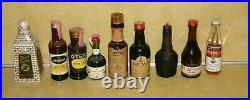
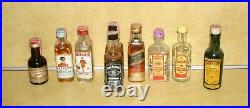
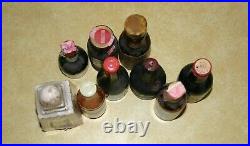
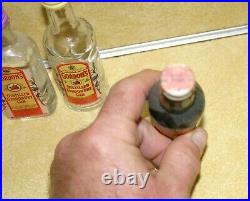
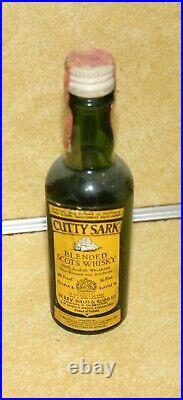
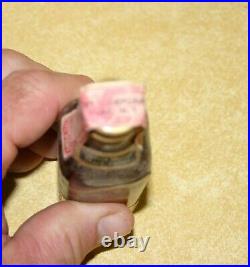
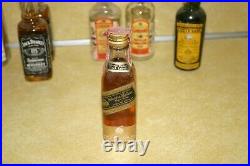
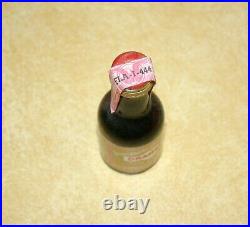

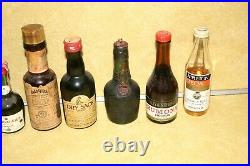
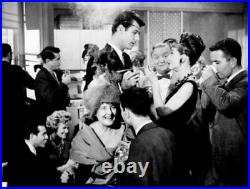

We welcome any comments, questions, or concerns. WE ARE TARGETING A GLOBAL MARKET PLACE. Thanks in advance for your patronage.
Please Be sure to add WDG to your. NOW FOR YOUR VIEWING PLEASURE. THE VALUE OF THE COLLECTIBLE BOTTLE/CONTAINER OR ITEM AND NOT THE CONTENT.
THE CONTAINER HAS NOT BEEN OPEN AND ANY INCIDENTAL CONTENTS ARE NOT INTENDED FOR COMSUMPTION. THIS ITEM IS NOT AVAILABLE AT ANY RETAIL OUTLET AND THE CONTAINER HAS A VALUE THAT SUBSTANTIALLY EXCEEDS THE CURRENT RETAIL PRICE OF THE ALCOHOL IN THE CONTAINER. BUYERS AND SELLERS BOTH ENSURE THAT THE SALE.
CUTTY SARK BLENDED SCOTS WHISKY STAMP READS: (THE BUCKINGHAM CORPORATION NEW YORK NY) JOHNNY WALKER BLACK LABEL READS: (CANADA DRY CORPORATION NEW YORK, NY) PRINCE CHARLES EDWARDS LIQUER DRMABUIE READS: (FLA-I-444) BEEFEATER LONDON DISTILLED DRY GIN READS: (KOBRAND CORPORATION NEW YORK, NY) (FULL LENGTH PICTURE OF GUARD) COURVOSIER VERY SPECIAL COGNAC READS (FLA-I-444) HUEBLEIN EXTRA DRY MARTINI (ORIGINAL PAPER LABEL) ESPIRITU DEL ECUADOR QUITO (ORIGINAL CELLOPHANE WRAP) HUBLEIN FULL STRENGTH MANHATTAN (ORIGINAL PAPER LABEL) (2) JACK DANIELS TENNESSEE SOUR MASH (ORIGINAL PAPER LABEL) (ALTERNATE BOTTLE HAS SMALL LABEL REMAINING) BRANDY (NO LABEL) (MADE INTO A CANDLE) APPPLETON SPECIAL JAMAICA RUM IMPORTED WRAY & NEPHEWS RUMONA LIQUEUR FINE BLENDED JAMAICAN RUM DRY SACK SHERRY WILLIAMS & HUMBERT PEREZ & LONDON IMPORTED FROM SPAIN (2) GORDON'S DISTILLED LONDON DRY GIN (ONE SEALED, ONE EMPTY) BEEFEATER VERY DRY MARTINI (PROFILE PICTURE OF SOLDIER) ANGOSTURA AROMATIC BITTERS PRODUCT OF TRINIDAD PORT OF SPAIN MANUFACTURED BY APPOINTMENT OF HER MAJESTY QUEEN ELIZABETH DR. 18 BOTTLES TAKE ONE OR ALL. A cocktail is a style of mixed drink. Originally a mixture of distilled spirits, sugar, water, and bitters, the word has gradually come to mean almost any mixed drink containing alcohol. A cocktail today usually contains one or more types of liquor and one or more mixers, such as bitters, fruit juice, fruit, soda, ice, sugar, honey, milk, cream, or herbs. The earliest known printed use of the word cocktail was in The Farmers Cabinet, April 28, 1803:Drank a glass of cocktail excellent for the head. Found Burnham he looked very wise drank another glass of cocktail. The earliest definition of "cocktail" was in the May 13, 1806, edition of the Balance and Columbian Repository, a publication in Hudson, New York, in which an answer was provided to the question, What is a cocktail?Cocktail is a stimulating liquor composed of spirits of any kind, sugar, water, and bitters it is vulgarly called a bittered sling and is supposed to be an excellent electioneering potion, inasmuch as it renders the heart stout and bold, at the same time that it fuddles the head. It is said, also to be of great use to a Democratic candidate: because a person, having swallowed a glass of it, is ready to swallow anything else.
Compare the ingredients listed (spirits, sugar, water, and bitters) with the ingredients of an Old Fashioned. The first publication of a bartenders' guide which included cocktail recipes was in 1862: How to Mix Drinks; or, The Bon Vivant's Companion, by "Professor" Jerry Thomas. In addition to listings of recipes for Punches, Sours, Slings, Cobblers, Shrubs, Toddies, Flips, and a variety of other types of mixed drinks were 10 recipes for drinks referred to as "Cocktails". A key ingredient which differentiated "cocktails" from other drinks in this compendium was the use of bitters as an ingredient, although it is not used in many modern cocktail recipes.The first "cocktail party" ever thrown was allegedly by Mrs. Louis, Missouri, in May 1917.
Walsh invited 50 guests to her mansion at noon on a Sunday. The party lasted one hour, until lunch was served at 1pm. The site of the first cocktail party still stands. In 1924, the Roman Catholic Archdiocese of St. Louis bought the Walsh mansion at 4510 Lindell Blvd.
And it has served as the local archbishop's residence ever since. During Prohibition in the United States (19201933), when the sale of alcoholic beverages was illegal, cocktails were still consumed illegally in establishments known as speakeasies. The quality of the alcohol available was far lower than was previously used, and bartenders generally put forth less effort in preparing the cocktails. There was a shift from whiskey to gin, which doesn't require aging and is therefore easier to produce illicitly. Cocktails became less popular in the late 1960s and 1970s as other recreational drugs became common.
In the 1980s cocktails once again became popular, with vodka often substituted for gin in drinks such as the martini. In the 2000s, traditional cocktails and gin are starting to make a comeback. Piña Colada cocktails with pieces of coconut.There are several claims about the origin of the term "cocktail, " many of which are fanciful and few of which are supported by documentary evidence. Barrel taps are known as cocks and the term tails usually referred to the dregs of distillate left at the end of a run in a distillery or at the bottom of a cask. The patrons would request the "cock tailings" or the tailings from the stop cock of the cask. Fighting cocks were given a mixture of spirits by their trainers before a fight. This mixture was known as a cocks-ale.
In Campeche, Mexico, local bartenders used wooden spoons carved from a native root known as cola de-gallo (cock's tail) to stir the local spirits and punches before serving. In tribal Ireland, clan chiefs would gather to consult on matters such as border disputes, and to discuss cooperative plans when the island's residents were faced with a common foe. These meetings would typically take place in the great hall of the hosting clan. The clan chiefs would seat themselves at a communal table and their mugs of mead would be adorned with a cock's tail to signify their status. A tavern near Elmsford, New York was popular with the officers of the Revolutionary soldiers of Washington and Lafayette.
The American troops preferred whiskey or gin, the French preferred wine or vermouth. All enjoyed a bit of brandy or rum. Sometimes late in the evenings, in a spirit of camaraderie, the spirits were mixed from one cup to another during toasts.
A soldier stole a rooster from the tavern owner's neighbor, who was believed to be a Tory supporter of George III of the United Kingdom. The rooster was promptly cooked and served to the customers, with the tail feathers used to adorn the accompanying drinks. The toasts accompanying this meal were "vive le cocktail" and the mixed drinks were so called ever after. Cocktails were originally a morning beverage, and the cocktail was the name given as metaphor for the rooster (cocktail) heralding morning light of day.
This was first posited in 2004 by Ted Haigh in "Vintage Spirits & Forgotten Cocktails". And can be distinguished from the theory "take two snips of the hair of the dog that bit you", which refers to consuming a small bit of alcohol the morning after a "binge drinking night" to curb the effects of the symptoms of the hangover, in the belief that these symptoms are the result of a form of withdrawal. A cock's tail has feathers in many varied colours as a cocktail has varied alcoholic drinks mixed together. Some say that it was customary to put a feather, presumably from a cock's tail, in the drink to serve both as decoration and to signal to teetotalers that the drink contained alcohol. Another etymology is that the term is derived from coquetier, a French double-ended egg-cup which was used to serve the beverage in New Orleans in the early 19th century.
In the 1800s it was customary to dock the tails of good horses of mixed breeds. These horses were referred to as cock-tails. The beverage known as a "cock-tail", like the horse, was neither strictly spirit nor wine it was a mixed breed, but a good horse nonetheless. After cokstele or cock-stick, a type of weighted stick used for throwing at cocks as a sport.The word could also be a distortion of Latin [aqua] decocta, meaning "distilled water". In the book, Under the Mountain, by Margaret Robson, published in 1958, the author states, James Fenimore Cooper stayed (at Hustler's Tavern) in Lewiston, New York in 1821 while writing The Spy. In The Spy, Cooper wrote of cock-tails being served in Betsy Flanagan's tavern. Cooper researched the novel by using information taken from war veterans and used the owners, Thomas and Catherine Hustler, as the models for Sergeant Hollister and Betty Flanigan. According to Cooper, it was Catherine Hustler who invented the gin cocktail, stirring it with a feather from a stuffed rooster's tail.
" Catherine Hustler described her drink by saying, "it warms both the soul and body and is fit to be put in a vessel of diamonds. Hustler's Tavern, which stood at the northeast corner of 8th and Center Streets in Lewiston, NY, is no longer standing.
(formerly traded as Seagram's) was a Canadian multinational conglomerate formerly headquartered in Montreal, Quebec. Originally a distiller of Canadian whisky based in Waterloo, Ontario, it was once (in the 1990s) the largest owner of alcoholic beverage lines in the world. Whose assets included Universal Studios and its theme parks, financed through the sale of Seagram's 25% holding of chemical company DuPont, a position it acquired in 1981.
Following this, the company imploded, with its beverage assets wholesaled off to various industry titans, notably The Coca-Cola Company, Diageo, and Pernod Ricard. Seagram's House, the former Seagram's headquarters in Montreal, was donated to McGill University by Vivendi Universal in 2002, then renamed Martlet House.
The Seagram Building, once the company's American headquarters in New York City, was commissioned by Phyllis Lambert, daughter of Seagram CEO Samuel Bronfman, and designed by architect Ludwig Mies van der Rohe with Philip Johnson. Regarded as one of the most notable examples of the functionalist aesthetic and a prominent instance of corporate modern architecture, it set the trend for the city's skyline for decades to follow, and has been featured in several Hollywood films. On completion its costs made it the world's most expensive skyscraper. In 1857, a distillery named Waterloo Distillery was founded in Waterloo, Ontario Canada. Seagram became a partner with George Randall, William Roos and William Hespeler in 1869 and sole owner in 1883, and the company became known as Joseph E.Many decades later, in 1924, Samuel Bronfman and his brothers founded Distillers Corporation Limited, in Montreal, which enjoyed substantial growth in the 1920s, in part due to Prohibition in the United States. The Distillers Corporation Limited name was derived from a United Kingdom company called Distillers Company Limited, which controlled the leading brands of whisky in the UK, and which was doing business with the Bronfmans. In 1928, a few years after the death of Joseph E.
Seagram (1919), the Distillers Corporation acquired Joseph E. Seagram & Sons from heir and President Edward F.
Seagram; the merged company retained the Seagram name. The company was well prepared for the end of Prohibition in 1933 with an ample stock of aged whiskeys ready to sell to the newly opened American market, and it prospered accordingly. Although he was never convicted of criminal activity, Samuel Bronfman's dealings with bootleggers during the Prohibition-era in the United States have been researched by various historians and are documented in various peer-vetted chronicles. After the death of Samuel Bronfman in 1971, Edgar M.Bronfman was named Chairman and Chief Executive Officer (CEO) until June 1994 when his son, Edgar Bronfman Jr. From the 1950s, most of the family holdings of Distillers-Seagram was held through holding company Cemp Investments, which was owned by the four children of Samuel Bronfman. The three most popular Seagram distilled products in the 1960s through 1990s were Seven Crown, VO, and Crown Royal. In 1981, cash-rich and wanting to diversify, the U.
Based subsidiary Seagram Company Ltd. Engineered a takeover of Conoco Inc. A major American oil and gas producing company. By 1995, Seagram was DuPont's largest single shareholder with four seats on its board. In 1986, the company started a memorable TV commercial campaign advertising its Golden wine cooler products.With rising star Bruce Willis as pitchman, Seagram rose from fifth place among distillers to first in just two years. In 1995, Edgar Bronfman Jr. Was eager to get into the film and electronic media business. Seagram was heavily criticized by the investment communitythe 24.3% stake in DuPont accounted for 70% of Seagram's earnings.
Bronfman used the proceeds of the sale to acquire a controlling interest in MCA, whose assets included Universal Pictures and its theme parks. In 2000, Edgar Bronfman Jr. By the time Vivendi began auctioning off Seagram's beverages business, the once-renowned operation consisted of around 250 drink brands and brand extensions in addition to its original high-profile brand names. In 2002, The Coca-Cola Company acquired the line of Seagram's mixers (ginger ale, tonic water, club soda and seltzer water) from Pernod Ricard and Diageo, as well as signing a long-term agreement to use the Seagram name from Pernod Ricard.
On April 19, 2006, Pernod Ricard announced that they would be closing the former Seagram distillery in Lawrenceburg, Indiana. They operated the distillery as Lawrenceburg Distillers Indiana. It is now known as MGP of Indiana, and continues to be the source of the components of Seagram's Seven Crown, now owned by Diageo. In 1997, the Seagram Museum, formerly the original Seagram distillery in Waterloo, Ontario, was forced to close due to lack of funds. The building is now the home of the Centre for International Governance Innovation as well as Shopify.The two original barrel houses are now the Seagram Lofts condominiums. There were almost 5 acres (2.0 ha) of open land, upon which the Balsillie School of International Affairs was subsequently built; construction began in 2009, and was completed in 2010.
(THIS PICTURE FOR DISPLAY ONLY). Please leave feedback when you have received the item and are satisfied. Please respond when you have received the item. Our goal is for 5-star service.
We want you to be a satisfied, return customer. Please express any concerns or questions. More pictures are available upon request. Please Check out our other items. WE like the curious and odd.
Get Supersized Images & Free Image Hosting. Create your brand with Auctiva's. Attention Sellers - Get Templates Image Hosting, Scheduling at Auctiva. MINI BAR LIQUOR BOTTLE TAX STAMP NEW YORK CANADA DRY FLORIDA BITTER GIN RUM" is in sale since Friday, May 14, 2021.This item is in the category "Collectibles\Bottles & Insulators\Bottles\Modern (1900-Now)\Miniatures". The seller is "cbenhob" and is located in Jenks, Oklahoma. This item can be shipped worldwide.
- Modified Item: No
- Country/Region of Manufacture: United States
- California Prop 65 Warning: No
- Color: Lot
- Time Period Manufactured: Modern (1900-Now)
